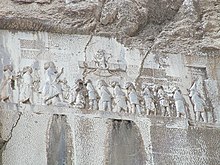Intaphrenes
Intaphrenes ( Greek: Ἰνταφρένες, old Persian: Vidafarnah ), son of Vāyaspāra, was a Persian nobleman of the Achaemenid Empire in the 6th century BC.
Conspirators
Intaphrenes was in the year 522 BC. Next to Otanes , Ardumaniš , Gobryas , Hydarnes , Megabyzos and Dareios one of the seven conspirators against the usurper Gaumata . He was initiated by the chief planner of the Otane conspiracy into the secret usurpation of the Persian throne by the magicians . During the fight in the royal apartments he was hit in one eye by a lance that he lost.
After the successful change of power, Intaphrenes served Dareios I as a general against the rebellious Babylonians under the " king of lies " Aracha (Nebuchadnezzar IV) , whom he saw in a battle on the 22nd day of the month of Markasanaš (November 27, 521 BC) defeated and captured.
At the court of Darius, Intaphrenes seems to have assumed one of the highest dignities, if not the highest, after the great king himself. In any case, on the relief for the famous Behistun inscription (see picture) he is assigned his own representation, which shows him standing as a royal arch bearer directly behind the great king, which marks a prominent position. Although no descriptive inscription is added to this figure, it is concluded from the fact that Intaphrenes is listed first in the Behistun inscription, the conspirators, that he must also be the king's first follower on the relief.
Downfall
After Darius I was enthroned, he had decided that his six co-conspirators should not only represent the highest nobility of the Persians, but should also be given unrestricted access to him according to their rank. So you could visit the Great King at any time of the day or night without prior notice or an audience, with only one exception, namely when the Great King was sleeping with one of his wives. One day the Intaphrenes was denied access to the Great King by the royal gate guards (probably “ apple bearers ”) on the grounds of this warning. Intaphrenes, however, did not believe the guards and had them tortured for disregarding his status .
After Darius I learned of this incident, he listened to the other five conspirators to see whether they agreed with the actions of the Intaphrenes. But when they expressed their disapproval, Darius had Intaphrenes, his wife and sons, and all other family members arrested and sentenced to death. For in his act the great king had recognized a violation of law and a sign of high treason. But the wife of Intaphrenes fell on her knees before the great king ( footfall ) and asked him for mercy, which aroused his pity. The Great King then not only pardoned the woman, but also granted her to save the life of one of her family members. To his surprise, the woman chose her brother on the grounds that she could take a husband again and have sons at any time, while she could not have another brother because her parents had already died. Dareios was so astonished at this justification that he let the woman choose one of her sons to live; she chose the elder. Intaphrenes and his other sons were executed.
literature
- Clara Shaw Hardy: Nomos and Replaceability in the Story of Intaphrenes and His Wife. in: Transactions of the American Philological Association (1974-). Vol. 126 (1996), pp. 101-109.
- HM Zellner: Antigone and the Wife of Intaphrenes. in: The Classical World. Vol. 90 (1997), pp. 315-318.
Remarks
- ↑ Herodotus , Historíai . 3, 70. Behistun-Inscription (DB), plate 4, §68 in: Roland G. Kent, Old Persian-Grammar Texts Lexicon . American Oriental Society, 1953. By the apparently faulty tradition of Ctesias ( . FrGrHist no. 688, Frag. 13, [on the edition of 16 Lenfant ]) mentioned Ataphernes could have been meant Intaphrenes.
- ↑ Herodotus, Historíai. 3, 78.
- ↑ Behistun inscription (DB), panel 3, §50.
- ^ Heinz Luschey: Studies on the Darius relief from Bisutum. in: Archaeological communications from Iran. Vol. 1 (1968), pp. 63-94.
- ↑ Herodotus, Historíai. 3, 118.
- ↑ Herodotus, Historíai. 3, 119.
| personal data | |
|---|---|
| SURNAME | Intaphrenes |
| ALTERNATIVE NAMES | Ἰνταφρένες (Greek); Vidafarnah |
| BRIEF DESCRIPTION | Member of the nobility in Persia, conspirator against Gaumata |
| DATE OF BIRTH | 6th century BC Chr. |
| DATE OF DEATH | 6th century BC BC or 5th century BC Chr. |
